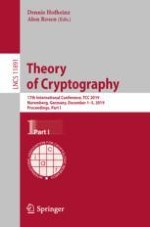2019 | OriginalPaper | Buchkapitel
Matrix PRFs: Constructions, Attacks, and Applications to Obfuscation
verfasst von : Yilei Chen, Minki Hhan, Vinod Vaikuntanathan, Hoeteck Wee
Erschienen in: Theory of Cryptography
Aktivieren Sie unsere intelligente Suche, um passende Fachinhalte oder Patente zu finden.
Wählen Sie Textabschnitte aus um mit Künstlicher Intelligenz passenden Patente zu finden. powered by
Markieren Sie Textabschnitte, um KI-gestützt weitere passende Inhalte zu finden. powered by
Abstract
-
We present constructions of matrix PRFs based on the conjectured hardness of computational problems pertaining to matrix products.
-
We show that any matrix PRF that is computable by a read-c, width w branching program can be broken in time poly\((w^c)\); this means that any matrix PRF based on constant-width matrices must read each input bit \(\omega (\log (\lambda ))\) times. Along the way, we simplify the “tensor switching lemmas” introduced in previous IO attacks.
-
We show that a subclass of the candidate local-PRG proposed by Barak et al. [Eurocrypt 2018] can be broken using simple matrix algebra.
-
We show that augmenting the CVW18 IO candidate with a matrix PRF provably immunizes the candidate against all known algebraic and statistical zeroizing attacks, as captured by a new and simple adversarial model.
